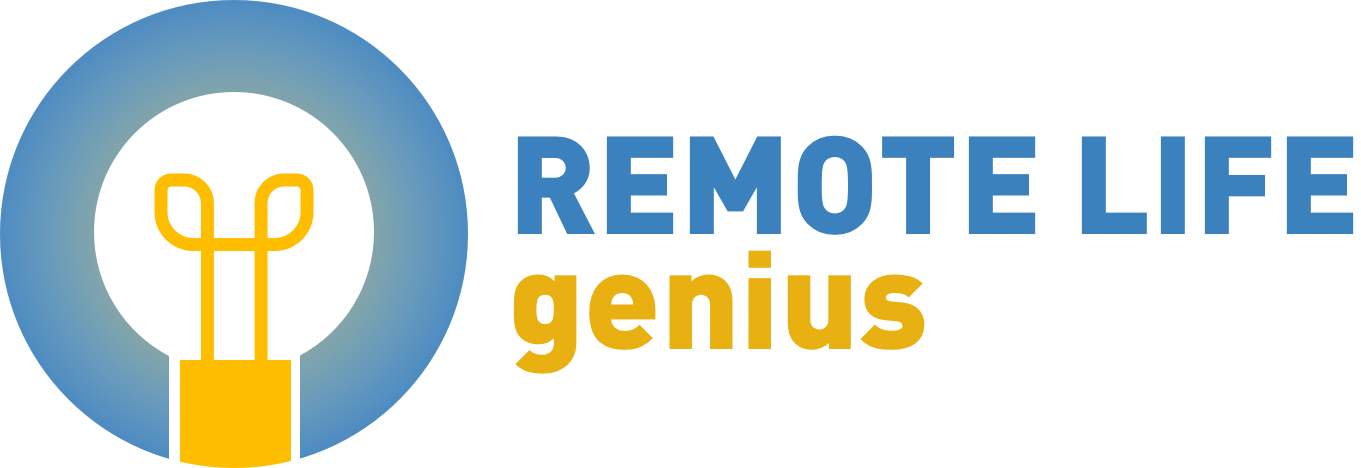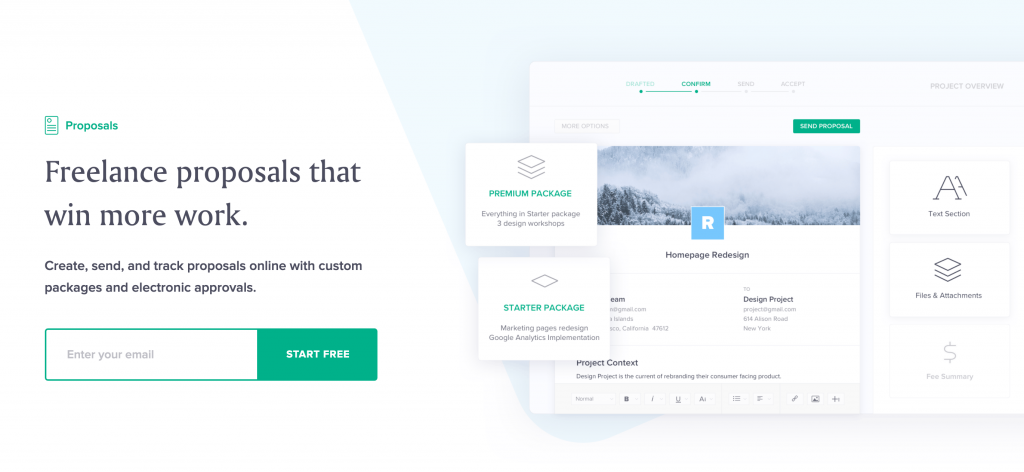 Writing proposals for your freelance work can feel daunting when you’re just starting. Then again, they might still be an obstacle even if you’re already freelancing full-time. Whether you’re just getting started or you have years of experience underneath your belt, learning how to write effective proposals that wow prospective clients can help your business.
Writing proposals for your freelance work can feel daunting when you’re just starting. Then again, they might still be an obstacle even if you’re already freelancing full-time. Whether you’re just getting started or you have years of experience underneath your belt, learning how to write effective proposals that wow prospective clients can help your business.
A sharp proposal can help you pull ahead of the competition and win bigger and better deals. And that means working on projects that you’re more interested in AND getting paid more.
At the heart of it, your proposal needs to convince your prospective clients that you are the solution they want and need. And to do that, you need to present meaningful content in a professional way.
This guide will walk you through the steps of creating a winning proposal that helps you win higher-paying gigs and clients.
Page Contents
The Basics – What is a Freelance Proposal?
A freelance proposal is simply a document that outlines the services you would provide to a potential client. Namely, it provides your prospective client with the expectations for working with you.
The requirements of the proposal often depend on each prospective client. For instance, an official RFP will contain specific requirements for each proposal submission. On the other hand, job posts on sites like Upwork will be less detailed in their requests. However, there are certain elements that are typically included in all proposals, they are:
- Your information
- Scope or description of services
- Price estimate and/or pricing structure
- Any applicable discounts you’re offering
- Timeline for delivery
- Payment details (ie. when is payment received)
- Provisions & guarantees
When to send a freelance proposal
Unlike cold outreach, proposals are submitted when they are asked for. Since proposals include details about the actual work or project, you only want to send a proposal when you know there is work available. For example, if a prospective client has posted a Request for Proposal (RFP) or they have posted on a job board, then it’s appropriate to submit a proposal. Likewise, if you had a conversation with a prospective client and they ask for a proposal/scope of work, you would submit one.
Proposals are often sent to the person who is hiring for the position, or whoever posted the job/RFP.
Options for Writing Your Proposals
There are several options when it comes to writing proposals, including writing from scratch, using templates, and using proposal software. Each has its own pros and cons, and you can choose which method to use based on a given situation.
Writing from scratch
 Writing proposals from scratch is the best way to craft a truly personalized proposal. This method allows you to tailor your messaging exactly to the prospective client. However, this is also the most time-consuming method.
Writing proposals from scratch is the best way to craft a truly personalized proposal. This method allows you to tailor your messaging exactly to the prospective client. However, this is also the most time-consuming method.
If you write all of your proposals from scratch, you won’t be able to apply to as many gigs. So, this is a good option if you’re testing out a new service, or if it’s a client that you really want to work with.
Using templates
To work faster and increase the number of proposals you create, you can use templates. In this case, you can choose to create your own personal templates or use one that’s already been created.
Although templates can help you work faster, they come with some risks. If you choose a poor template, then each proposal you submit will be ineffective, and you’ll likely not see a high response rate. Additionally, if you try to work too fast, then your templates will lack personalization and seem mechanical.
That being said, templates can be a great option if you specialize in a certain service or industry. The more specific your templates can be, the better. We recommend working from scratch in the beginning and then crafting personal templates based on your successful proposals.
Another great option for beginners is to use templates as a baseline, but adapt them to your personality. You should always make sure to leave room in each template to personalize the proposal for a prospective client.
Proposal software
There are several types of software that help freelancers write and submit proposals faster, and they’re known as proposal management software. Not only do they help out with templates and design, but they also allow you to store your past proposals for easy access. These services are often priced as a subscription model, sometimes with various tiers.
Moreover, some of the software include other services such as contract and invoice management. If you’re freelancing full-time, this is a great way to keep all of your documents in order.
Some notable proposal management software includes Better Proposals, Bidsketch, PandaDoc, and Bonsai.
6 Tips for a Great Proposal
1 – Keep it short
Proposals might be a pain to write, but luckily, they are not the great American novel. Your proposals should be as reader-friendly as possible. Get in the habit of including the details that are most important to your prospective client and cutting out any irrelevant details.
If you have trouble with writing short proposals, try these steps to cut your writing down.
- Remove services that you offer, but aren’t relevant to a prospective client
- Remove proof points for irrelevant services
- Keep guarantees concise (they’re stronger this way)
- Don’t give too many options for payment/timeline, be decisive
- Make sure the important details are easy to find
Remember, the proposal isn’t the final work order. It’s not your job to include every possible option that your client wants. Rather, it’s your job to intrigue the client enough and generate enough excitement and trust that they want to work with you.
All it has to do is convince them to work with you. If a prospective client likes your proposal enough, he or she will reach back out to discuss other options or negotiate timeline and price. Don’t try to accomplish the entire process in one document.
2 – Sharpen your ax & solve a problem
 Clients don’t hire you because you need a job. They hire you to solve a problem, to make their lives easier, to make them more money. Your proposal does need to talk about you, but always in the context of “How do you solve their problem?”
Clients don’t hire you because you need a job. They hire you to solve a problem, to make their lives easier, to make them more money. Your proposal does need to talk about you, but always in the context of “How do you solve their problem?”
Think of your prospective client before you write and as you write your proposal. Abraham Lincoln once said,
“If you give me six hours to chop down a tree, I will spend the first four sharpening the ax.”
Use this approach in your proposal writing. Ideally, the first half of writing your proposal doesn’t actually involve writing. Instead, you should spend it understanding the job description, doing basic client research, and thinking.
Once you know how to answer the question, “Why am I the ideal solution to their problem?” Then, and only then, do you start writing. Especially if this is a client that you really want to work with.
In order to write a good proposal, you need to know the following:
- What is my prospective client’s problem?
- What are their biggest concerns with the solution? (price, quality, on-time delivery?)
- How am I different/better than other possible solutions?
When you know what matters most to your client, it’s easier to cut out the extra fluff and write a short but effective proposal.
3 – Choose the right tone: friendly and professional
Like anyone else, your prospective client will use both emotion and logic to make a hiring decision. Your proposal should cater to both motivations. Of course, by sharpening your ax and doing your research, you will be able to meet their logical needs.

However, that’s not always enough. People want to work with people they like. So, make sure that the tone you use conveys professionalism and likeability. These are the little details that can set you apart from your competition.
A point often overlooked is your greeting and your sign-off. Small changes like writing “Dear Mr. So and So” instead of “Hi” can be powerful. Likewise, before you sign off, be sure to thank your prospective client for his or her time.
Now, take this with a grain of salt. If overly-formal writing doesn’t come naturally to you, then maybe it’s better to sound like yourself. However, if you’re choosing between two options, we always recommend choosing a more courteous option.
4 – Anticipate Questions
This is perhaps one of the most effective strategies to use when writing proposals. And, it’s why the research part of “sharpening your ax” is so important. Your past experience on similar projects can also help you here.
Nothing makes a client feel like, “Wow, this person understands me.” like answering questions before they have a chance to ask them.
A truly winning proposal answers your prospective client’s questions as they pop into their head. The more you work with potential clients, the better you’ll become at this skill.
For example, if you offer website design and creation services but your clients frequently contact you for updates every month you can use that. Include “website design” in your scope of work and then make a (short) note that there is an option for a “monthly maintenance retainer”.
Similarly, you can also achieve this effect by using well-placed work samples. If your clients are always asking to see prior work before hiring you, include the prior work in your proposal. Your client will be wondering, “has he or she done this before” and bam! your work samples say, “yes, yes I have.”
5 – Highlight Your Strengths Correctly
The number one question you should always anticipate is, “Why should I work with you?” Every prospective client will be asking this one, and the answer lies in your unique strengths.
Your goal is to make them feel comfortable and excited about working with you.
You can answer this question by including:
- Your years of experience in the industry
- Years of experience freelancing
- Past clients/projects
- Feedback/testimonials
- Awards or certifications
- Education
As always, only include details that are relevant to the proposal.
6 – Format Professionally (The Correct Way to Use Templates)
The first thing a prospective client will notice about your proposal is how it looks. If your proposal has a distracting layout or an unpolished look, then your words might not even matter. So, don’t ruin all your hard work by cutting corners on layout and appearance.
This is where templates truly shine. Using a template for formatting can save you a lot of time when writing proposals. Now, these can be simple, for certain proposals a Word Doc is perfect. Other times, you may want to create a slide deck with added visual elements. Particularly if you are providing design or illustrating services. Another time you might consider a more stylized presentation is if you’re making a proposal for a company you’re already working with.
Proposal management software often comes with format templates that can take your proposal to the next level. Bonsai online software offers a free trial of their services, you can try it here.
In Summary
Proposals are a necessary evil for freelancers and creative entrepreneurs. But, if you practice this skill and learn to create winning proposals, you can turn them into a competitive advantage.

In addition to proposals, it’s important to master networking, prospecting, cold outreach, and inbound marketing for your creative business. One of the best tools in your kit for inbound marketing includes creating your own professional website.
A professional site gives you one place to highlight your strengths, outline your services, and convince potential clients to work with you. A great website will even have clients reaching out to you, instead of the other way around.
If you want to learn how to create a professional website, enroll in our online Website Creator Course. In just 5 days you’ll be able to launch a winning website in just 5 days. Learn more here.
Want to save these tips? Pin the article to read it later.






